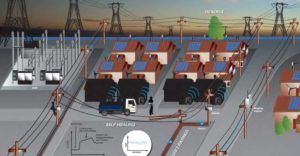
Unison Networks added a Smart Grid Initiative to their Asset Management Plan in 2011 with the goal of leveraging off new technology to improve and expand upon the services it provides to its customers, reduce etwork expenditure and obtain the twelve stated network benefits while creating revenue growth opportunities.
The Smart Grid Initiative has been designed to deliver benefits an order of magnitude greater than the investment required by improving the efficiency of the underlying assets employed. In practical terms this means being able to run assets harder for longer without materially increasing the risk of failure. The initiative will also deliver classes of benefits not currently available as the network becomes more responsive to the demands of the customer.
At the highest level the network benefits offered by the Smart Grid Initiative are:
| Category | Benefits |
|---|---|
| Reduction in network expenditure |
|
| Improvement in customer service |
|
| Safer and more sustainable network |
|
Unison Networks views smart grid applications as aligning to three areas: EMS technologies, smart metering, and load control (including systems and communications). Unison has developed a strategy for a more aggressive implementation of smart grid applications through the deferment of low risk asset refurbishment that, in turn, releases capital to be spent on the application of smart grid technologies. For example, if a substation transformer is in need of low-risk refurbishment, Unison may defer the refurbishment and fast switching technology will be installed. This results in the same or improved risk profile, as the fast switching allows load to be lifted several times faster avoiding additional transformer degradation.
Unison bases decisions on a return on investment (ROI) calculation. This ROI is computed by capturing available information on costs and benefits using a New Zealand-customised smart grid benefit tool. This tool drives the Unison 5-year asset management plan, with technology trials as part of the approach. However, even with this developed ROI process it is still difficult to understand some aspects of cost, for example the value of lost load in commercial and residential settings. The EA has estimated the value of lost load at about $0.5 million for each region based on a nation-wide assessment. The EA is looking to produce regional estimates using 2010 survey data for from the Automatic Under-Frequency Load Shedding (AUFLS) implementation.
| Technology | Description | Benefits |
|---|---|---|
| Distributed Temperature Sensing (DTS) | This technology is being used by Unison to monitor critical high voltage circuits. DTS is able to locate hot spots on the cable route helping to identify issues which could become major problems in the future. DTS also aids in calculating the real-time dynamic rating of the circuit. |
|
| Thermal Sensors | This sensor technology measures soil thermal resistivity. Thermal resistivity of soil is the biggest unknown factor when it comes to calculating the rating of a circuit. By accurately determining the soil's thermal resistivity, the current carrying capacity of the cables can be accurately calculated. |
|
| Power Transformer Management System | This technology is used for managing the most important and expensive individual assets in the power distribution industry, the power transformer. By installing different types of monitoring equipment such as winding and oil temperature sensors and combining this with annual moisture and DGA tests, the condition and rating of transformers can be accurately determined. |
|
| Self-healing network | A self-healing network is a system comprised of sensors, automated controls, and advanced software that utilizes real-time distribution data to detect and isolate faults and to reconfigure the distribution network to minimize the customers impacted. |
|
| Installation of automated switches | Allows real time monitoring and control of the distribution network. It automates decision making while enabling optimised load shifting that manages network constraints, alleviates overloading conditions, reduces outage occurrence and duration, and creates a more efficient electricity distribution system. |
|
| Advanced Distribution Management System | Advanced Distribution Management System (ADMS) is a system that combines SCADA, Outage Management and Network Management functions together into one system. Network Management functions include engineering and network analysis tools. |
|